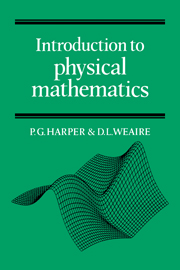Book contents
- Frontmatter
- Contents
- Preface
- Some notes on notation
- 1 Introduction
- 2 Errors
- 3 Cartesian coordinates
- 4 Vectors
- 5 The scalar product
- 6 The vector product and rotation
- 7 Matrices in physics
- 8 The transformation of matrices
- 9 The matrix eigenvalue equation
- 10 Exponential and logarithm functions
- 11 Sine and cosine functions
- 12 Graph plotting and curve sketching
- 13 Differentiation
- 14 Approximations
- 15 Power series and Taylor's expansion
- 16 Partial differentiation
- 17 Integration
- 18 The differential equation
- 19 Solving first-order differential equations
- 20 Second-order differential equations
- 21 Solving second-order differential equations
- 22 The complex exponential
- 23 The circuit equation
- 24 Harmonics and Fourier series
- 25 The diffusion equation
- 26 Waves
- 27 The rate of change of a vector
- 28 The scalar field and gradient operator
- 29 The vector field
- 30 Line integration
- 31 The potential field
- 32 Surface and volume integration
- 33 Flux and divergence
- 34 Circulation and the curl
- 35 Conclusion
- 36 Miscellaneous exercises
- Index
26 - Waves
Published online by Cambridge University Press: 20 October 2009
- Frontmatter
- Contents
- Preface
- Some notes on notation
- 1 Introduction
- 2 Errors
- 3 Cartesian coordinates
- 4 Vectors
- 5 The scalar product
- 6 The vector product and rotation
- 7 Matrices in physics
- 8 The transformation of matrices
- 9 The matrix eigenvalue equation
- 10 Exponential and logarithm functions
- 11 Sine and cosine functions
- 12 Graph plotting and curve sketching
- 13 Differentiation
- 14 Approximations
- 15 Power series and Taylor's expansion
- 16 Partial differentiation
- 17 Integration
- 18 The differential equation
- 19 Solving first-order differential equations
- 20 Second-order differential equations
- 21 Solving second-order differential equations
- 22 The complex exponential
- 23 The circuit equation
- 24 Harmonics and Fourier series
- 25 The diffusion equation
- 26 Waves
- 27 The rate of change of a vector
- 28 The scalar field and gradient operator
- 29 The vector field
- 30 Line integration
- 31 The potential field
- 32 Surface and volume integration
- 33 Flux and divergence
- 34 Circulation and the curl
- 35 Conclusion
- 36 Miscellaneous exercises
- Index
Summary
Confronted with an expanse of still water in a pond, who can resist the temptation to do the obvious experiment, to fling a stone into its centre? The disturbance thus created travels outwards, is reflected at the pond's edge and eventually disappears. Equilibrium is restored.
Such a disturbance is called wave motion. It is similar to the oscillatory motion that we have studied in chapters 21 and 23, except that it describes the behaviour of an extended medium (the surface of the pond) whose equilibrium is disturbed. The appropriate mathematical description must involve a function of several variables, since the height of the pond's surface is a function of position (x, y) as well as time (t). Already we can expect that a partial differential equation may be the key to understanding it.
Physicists are always striving for unified descriptions of the physical world. In the nineteenth century a variety of apparently different phenomena came to be understood in terms of waves – elastic waves in solids, sound waves in air, and, most importantly, electromagnetic waves. These include light, x-rays, radio waves, infrared radiation and so on, and constitute in themselves another important “unification” of physics. All of these types of waves and many others have a common mathematical description, at least up to a point.
One of the great surprises of modern physics in this century was the realisation that matter itself also has wave-like properties, described by quantum mechanics.
- Type
- Chapter
- Information
- Introduction to Physical Mathematics , pp. 184 - 193Publisher: Cambridge University PressPrint publication year: 1985



